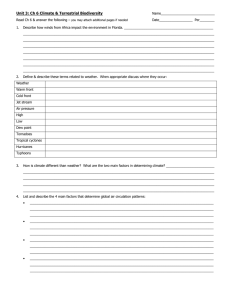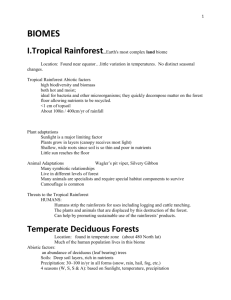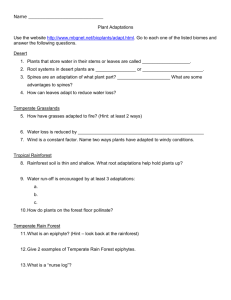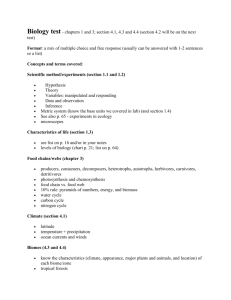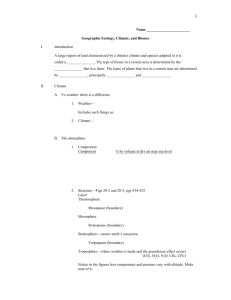Chap 4
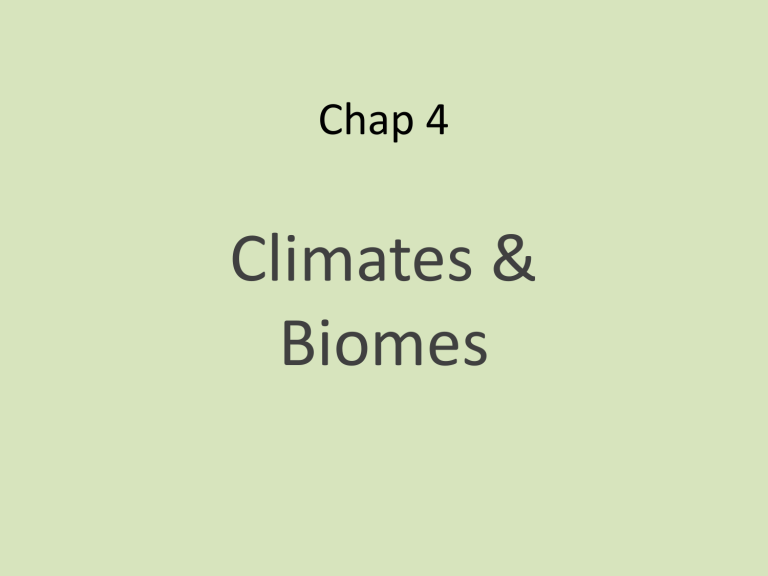
Chap 4
Climates &
Biomes
Climate
– Determined by
• temperature
• precipitation
– Affects species distribution
• Species adapt to conditions
– Different climates lead to different communities of organisms, especially vegetation.
– Affected by
• Topography
• Wind currents
• Ocean currents
• Elevation
• Latititude
Topography and Local Climate:
• Interactions between land, oceans, mountains, & cities affect local climates.
Figure 5-8
US Topography
Figure 3-9
Ocean currents influence climate by distributing heat mixing and distributing nutrients.
Wind Currents:
Convection Cells
• Heat & moisture are distributed over the earth’s surface by vertical currents, which form six giant convection cells at different latitudes.
Figure 5-6
Latitude & Elevation
• Similar changes occur moving from:
– the equator to the poles: Latitude
– lowlands to mountaintops: Elevation
Figure 5-11
Biomes:
Large regions categorized by:
• Climate (Temp & Precipitation)
• Soil
• Plant (& animals to lesser degree)
Each biome contains many ecosystems whose communities have adapted to differences in climate, soil, and other environmental factors.
Temperature & Precipitation
Biome
High mountains
Polar ice
Polar grassland (arctic tundra)
Temperate grassland
Tropical grassland (savanna)
Chaparral
Coniferous forest
Temperate deciduous forest
Tropical forest
Desert
Tropic of
Cancer
Equator
Tropic of
Capricorn
Fig. 5-9, p. 106
Biome: determined by precipitation, temp, & soil type
3 Categories
A. Cold – avg Temp below 5°C (41°F)
1. Tundra
2. Boreal
B. Temperate – avg Temp 5°C to 20°C (68°F)
3. Temperate Rainforest
4. Temperate Seasonal Forest (Deciduous)
5. Woodland/Shrubland (Chaparral)
6. Temperate Grassland / cold desert
C. Tropical – avg Temp above 20°C
7. Tropical Rainforest
8. Savanna / Tropical Seasonal Forest
9. Subtropical Desert
Climate diagrams Show Temp/Precip
Growing season
Tundra
Cold, treeless with low-growing vegetation.
In winter, the soil is completely frozen.
Growing season is very short, about 4 months during summer.
The underlying subsoil, known as permafrost is an impermeable, permanently frozen layer that prevents water from draining and roots from penetrating.
Tundra
• Climate – cold year round, very little rain, but wet in summer (melting)
• Located – near the poles
• NPP – low
• Decomposition – very slow
• Soil – nutrient depleted, thin and often frozen
• Limiting Factors – water, sunlight , cold, nutrients
• Biodiversity – low
– Vegetation – low growing plants
• Adaptations include: shallow roots for frozen soil, grow close together for warmth, grow underneath snow
– Animals – birds and mammals in summer, wolves, foxes and bears year round
• Adaptations include: migration and hibernation for winter, summer and winter “coats”,
• Major Human impacts – climate change, resource exploration (oil, gas, etc)
Boreal Forest
primarily coniferous (conebearing) evergreen trees that can tolerate cold winters and short growing seasons.
found between about 50˚ and 60˚ N
Europe, Russia and North
America. very cold climate, plant growth is more constrained by temperature than precipitation.
The soil is nutrient-poor due to slow decomposition.
Boreal Forest
(Taiga, Coniferous Forest)
• Climate –cold year round, moderate rain all year
• Located – around 60 o latitude
• NPP – moderate
• Decomposition – low
• Soil – nutrient poor and acidic
• Limiting Factors – cold, nutrients, light, water
• Biodiversity – moderate
– Vegetation – mostly evergreen trees (conifers)
• Adaptations include: needles to conserve water and energy, chemicals to repel grazers, shaped to allow snow to slide off
– Animals – grazing animals including moose, bears, bobcats, chipmunks and squirrels
• Adaptations include: insulating layers of fur or feather, seasonal color changes, migration
• Major Human impacts – forestry, acid rain, resource exploration, climate change
Temperate Rainforest
Moderate temperatures &high precipitation
Coast biome and can be found along the west coast of North America from northern California to
Alaska, in southern Chile, on the west coast of New Zealand, and on the island of Tasmania.
The ocean currents help moderate temperature & provide a source of water vapor.
nearly 12-month growing season: winters are rainy and summers are foggy.
The mild temperatures and high precipitation supports the growth of very large trees.
Temperate Rain Forest
• Climate – moderate temperatures year-round and seasonal rainfall (foggy summers)
• Located – in the Northwest US/Canada, southwest Argentina and the east coast of
Australia
• NPP – high
• Decomposition – slow due to cool temps
• Soil – nutrient poor and acidic
• Limiting Factors – light and soil nutrients
• Biodiversity – moderate
– Vegetation – large coniferous trees, ferns and mosses
• Adaptations include: climbing or hanging to access sunlight, leaf shape to allow water to fall
– Animals – wide variety including slugs, wolves and deer
• Adaptations include: camouflage to hide, migration, and hibernation
• Major Human impact – Logging and tree farming
Temperate Seasonal Forest
• Receive over 1 m (39 inches) of precipitation annually.
• Found in the eastern United
States, Japan, China, Europe,
Chile and eastern Australia.
• Dominated by broadleaf
deciduous trees such as beech, male, oak and hickory.
• Warmer summer temperatures favor decomposition so soils generally contain more nutrients than those of boreal forests.
Temperate Seasonal Forest
(Deciduous Forest)
• Climate –wet year round with 4 seasons
• Located – 30-60 o latitude
• NPP – high
• Decomposition – rapid
• Soil – fertile due to decomposing leaf litter
• Limiting Factors – sunlight, cold winters
• Biodiversity – high
– Vegetation –mostly deciduous trees with multiple lower layers
• Adaptations include: trees lose leaves in winter to conserve energy,
– Animals –wide variety and diverse food web
• Adaptations include: hibernation, migration or food storage for winter, camouflage
– Major Human impact – Deforestation for agriculture and logging
Woodland/Shrubland:
Chaparral
• Found on the coast of southern
California, southern Australia, southern Africa and in the area surrounding the Mediterranean
Sea.
• Hot, dry summers and mild, rainy winters
• There is a 12-month growing season, but plant growth is constrained by low precipitation in summer and by relatively low temperatures in winter.
• Wildfires are common and plants are well adapted to both fire and drought.
Woodland / Shrubland
(Chaparral)
• Climate – mild temperatures with a rainy and dry season
• Located – 30-60 o latitude near bodies of water
• NPP –moderate
• Decomposition – moderate
• Soil – nutrient poor (rain leaches nutrients)
• Limiting Factors – rainfall in summer, low temps in winter, fire maintained
• Biodiversity – moderate
– Vegetation – scrub-like plants that are similar to desert plants, succulents and drought tolerant trees
• Adaptations include: storing water, waxy coatings, deep roots, leaves turn brown or fall off to conserve water, fire adapted
– Animals – variety of small animals like lizards, snakes, deer, owls, and some larger predators like mountain lions
• Adaptations include: nocturnal, live close to the ground, camouflage, burrowing
• Major Human impacts – human started fires and fire suppression activities, urbanization
Temperate Grassland/
Cold Desert
• lowest average annual precipitation of any temperate biome.
• These are found in the Great Plains of North America, in South America, and in central Asia and eastern
Europe.
• Cold, harsh winters and hot, dry, summers
• Plant growth is constrained by both insufficient precipitation in summer and cold temperatures in winter.
• Plants include grasses and non woody flowering plants that are well adapted to wildfires and frequent grazing by animals.
Temperate Grassland / Cold Desert
• Climate – distinct seasons with a rainy and dry season
• Located –between 30-60 o latitude
• NPP – low
• Decomposition – rapid
• Soil – excellent, deep and nutrient dense
• Limiting Factors – water in summer, cold in winter, fire maintained
• Biodiversity – moderate (but varies)
– Vegetation – mostly grasses, tall grasses in wetter areas, low grasses in drier areas
• Adaptations include: deep roots, fire adapted,
– Animals –
• Adaptations include:
• Major Human impact – agriculture
Tropical Rainforest
• average annual temperatures exceed 20˚C.
• located approximately 20˚
N and S of the equator.
• found in Central and
South America, Africa, SE
Asia, & NE Australia.
warm and wet with little temperature variation.
• more biodiversity than any other terrestrial biome and contain up to two-thirds of
Earth's terrestrial species.
Tropical Rain Forest
• Climate - Warm year-round, wet and humid year round
• Located - near equator, specifically around the
ITZC
• NPP - High
• Decomposition – rapid
• Soil - thin, nutrient poor and acidic because decomposition rates are so rapid
• Limiting Factors – light, soil nutrients
• Biodiversity – highest on land
– Vegetation – a wide variety, but dominated by broadleaf evergreen trees
• Adaptations include: waxy leaves to keep extra water out, leaves shaped to allow water to drip off
– Animals – wide variety with a diverse and complex food web
• Adaptations include: Camouflage and specialization
• Major Human impact – deforestation for farming
Tropical Seasonal Forest /
Savanna
• Warm temperatures and distinct wet and dry seasons
• Central America, on the Atlantic coast of South America, in southern Asia, in northwestern
Australia, and in sub-Saharan
Africa.
• Soil is fairly fertile and can be farmed due to high decomposition rates, but the low amount of precipitation constrains plants from using the soil nutrients that are released.
• Grasses and scattered deciduous trees are common.
Tropical Seasonal Forest / Savanna
• Climate - Warm year round with a rainy season and a dry season
• Located – south of the equator between 30-60 o
• NPP - High
• Decomposition – moderate
• Soil – fairly fertile
• Limiting Factors – water, fire maintained
• Biodiversity – varies based on rainfall with scattered trees and tall grasses
– Vegetation – forests in the wetter areas, grasses in less wet areas
• Adaptations include: losing leaves during dry season to conserve water, fire maintained community
– Animals – wide variety particularly grazers and predators
• Adaptations include: Nocturnal hunting during dry season, migration for water, burrowing to avoid water loss, specialized hunting and defensive traits
• Major Human impact - deforestation for farming
Subtropical Desert
• This biome is found at 30˚ N and S with hot temperatures and extremely dry conditions.
• The Mojave Desert in the southwestern United States, the Sahara in Africa, the
Arabian Desert of the
Middle East and the Great
Victoria Desert of Australia are all subtropical deserts.
• Cacti, euphorbs and succulent plants are well adapted to this biome.
Subtropical Desert
• Climate - Warm and dry year round
• Located – 30 o above and below the equator
• NPP – Very low
• Decomposition – very slow
• Soil – almost non-existent
• Limiting Factors – water, nutrients
• Biodiversity – varies based on rainfall with scattered trees and tall grasses
– Vegetation – sparse and generally low to the ground with shrubs, cacti and succulents
• Adaptations include: no leaves, waxy coatings and water storage to conserve moisture, deep or very spread out roots to reach water, spines and protection from grazers
– Animals – wide variety particularly grazers and predators
• Adaptations include: Nocturnal animals, hibernation to escape heat, water conserving (dry feces, moisture absorbing skin) and avoid overheating (reflective skin, burrowing)
• Major Human impact – off road vehicles destroy delicate soil crust and threaten organisms
Forested Biomes
• All forested biomes receive a sufficient amount of rainfall to support trees
• Community of plants and animals are typically distributed in various layers:
– Emergent layer of branches above the canopy
– Canopy of full–grown trees
– Understory of tree saplings
– Undergrowth of herbaceous plants and shrubs
Another way to organize Biomes:
Cold, Temperate, & Tropical for :
Desert
Grassland
Forest
ARCTIC
Polar Deserts
ANTARCTIC
Cold & Temperate Deserts
Great Basin Desert (NV/UT) Woodland/Shrubland/Chapparal
Hot/Subtropical Deserts
Cold Grasslands (Tundra)
Temperate/Seasonal Grasslands
(Prairie/Steppe)
Tropical Grassland (Savanna)
Cold Forest (Boreal Forest/Taiga)
Temperate/Seasonal Forests
Deciduous (Seasonal) Forest
Temperate Rainforest
